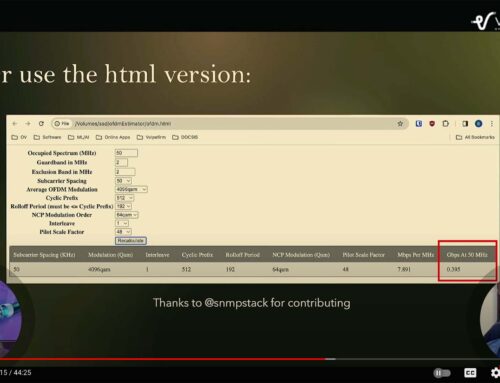The DOCSIS 3.1 PHY specification includes several PNM parameters and tests. One of the most useful downstream tests for OFDM is called receive modulation error ratio (RxMER) per subcarrier. RxMER per subcarrier provides an MER measurement for each subcarrier in the OFDM (downstream) or OFDMA (upstream) channel. This means if an OFDM channel has 7600 subcarriers, the RxMER per subcarrier data will provide 7600 MER results, one corresponding to each subcarrier. When plotted, it looks like a spectrum analyzer chart, but has different meanings. See Figure 1 for an example plot of OFDM RxMER per subcarrier data.

In Figure 1 there are some important observations one can make. First, the average RxMER is 29.85, as shown in the top left of the chart. A red line is added at 39 dB MER, which is the minimum threshold for 4096-QAM per the DOCSIS PHY specification. Ideally, all RxMER datapoints should be above the red line to provide the highest level of data speed to the subscriber. If the CMTS was only configured to provide 4096-QAM, this modem would not be able to reliably receive any data. Fortunately, CMTSs are configured to support multiple downstream modulations, called profiles. This allows the modem to drop to a lower modulation, such as 512-QAM, to operate with an average RxMER per subcarrier of 29.85 dB. (See Table 1 for the mapping of RxMER to OFDM and OFDMA modulation.)
Finally, there are two sections of the RxMER plot where the chart goes off the screen: one between 749 MHz and 757 MHz, and another between 851 MHz and 865 MHz. These are called exclusion bands. Exclusion bands are configured in the CMTS to disable subcarriers where the cable operator knows high levels of RF ingress exists, such as LTE interference. Exclusion bands are helpful to disable subcarriers which we know can be severely impacted no matter how hard we work to clean up the HFC plant.
RxMER can be directly mapped to the modulation level which can be supported by a receiving cable modem. These mappings are defined in [PHYv3.1] (see Table 46 – CM Minimum CNR Performance in AWGN Channel) and the [CM- OSSIv3.1] (see Table 72 – CmDsOfdmRequiredQamMer Object).

Table 1 shows a reliability matrix from the PNM Best Practices Primer: HFC Networks (DOCSIS® 3.1) document. As an example, for reliable operation at 1024-QAM with RxMER equal across all subcarriers, empirical evidence shows that the RxMER must be above 30 dB. If the ThresholdRxMerValue, the RxMER for the lowest 2% of subcarriers, falls below 29 dB, uncorrectable errors begin to appear, which means 1024-QAM can no longer be reliably supported by the relevant channel. The number of bit errors across the poor-quality subcarriers exceeds what the LDPC FEC can correct. Instead of looking at the RxMER of every individual subcarrier, the 2nd percentile threshold RxMER value can be monitored to confirm whether or not a specific modulation profile can be supported by the channel. [1]
Why is RxMER per subcarrier valuable?
If you are deploying DOCSIS 3.1 OFDM channels today it is a good idea to become familiar with RxMER per subcarrier analysis. It will quickly tell you the following things about the performance of a subscriber’s modem:
- If the subscriber has very good RxMER across the band, they should realize good data speed with their DOCSIS 3.1 modem on the OFDM channel.
- If the subscriber’s RxMER is very low or below 24 dB, it would be expected that the subscriber is likely not able to use the OFDM channel at all and possibly the reason they are complaining about high-speed data issues.
- RxMER data can be used to determine how far from threshold the modem is. For example, let us say the subscriber is complaining about intermittent issues. Seeing that RxMER is right at the threshold or maybe 1 dB from the threshold of 4096-QAM would help a technician understand that everything may be fine while they are at the subscriber’s home, but during changing weather, the RxMER may cross the threshold and cause the subscriber issues.
- Consider the fact that RxMER will often have variation over frequency, such as roll-off. Low frequencies may be fine, but higher frequencies can be awfully bad. In many scenarios the modem may experience unpredictable issues. Having visibility into the RxMER per subcarrier data gives insight not available with spectrum data only.
Keep reading at Broadband Library





Leave a Reply